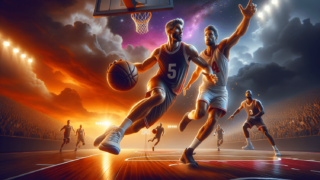
Are you ready to dive into the intricacies of one of basketball’s most fascinating defensive schemes? Look no further! In this blog post, we will be exploring the 3-2 zone defense, a versatile and adaptive strategy designed to keep opponents guessing and limit their scoring opportunities. Perfect for the curious and dedicated basketball enthusiasts out there, we’ll break down the ins and outs, the whys and hows, and the tips and tricks to master this everlasting dance between offense and defense. So get ready to lace up your sneakers, adjust your headband, and get ready to learn all about the 3-2 zone defense and how it can revolutionize your basketball game!
What’s a 3-2 Zone Defense in Basketball?
A 3-2 zone defense in basketball is a strategic scheme where the defending team assigns five players into two distinct lines – three players positioned near the perimeter and two players near the basket. This formation aims to limit opponents’ access to the middle, especially near the paint, while putting pressure on perimeter shooters, forcing them to take difficult shots or commit turnovers.
Understanding the Roles and Responsibilities of Each Player in a 3-2 Zone Defense
Before we jump into the details, it’s crucial to understand the roles and responsibilities of each player within the 3-2 zone defense. Essentially, the five defenders give a dual-layered coverage on the court, forming an arc in the shape of an elongated half-moon.
Top Three Defenders
Positioned near the perimeter, the top three defenders are responsible for cutting off passes to the wings, putting pressure on outside shooters, and preventing any drives towards the middle. They often switch, rotate, and cover each other while maintaining a close watch on the three-point line. This is the first line of defense that helps deny easy penetration into the paint or an uncontested shot.
Bottom Two Defenders
In the 3-2 zone, the bottom two defenders position themselves in front of the basket, creating a protective wall against any inside offensive movements. Their primary tasks include guarding the post area, contesting shots, grabbing rebounds, and covering any cutters trying to breakdown the zone. These two inside defenders act as the second line of defense to contain and challenge attacks that penetrate the front three.
Breaking Down the Dynamics of the 3-2 Zone Defense
Now that we know the primary roles, let’s dive into the dynamics of the 3-2 zone defense and learn how this system can manipulate offensive movements and force teams into unfavorable situations.
Communication is Key
A successful 3-2 zone defense requires strong communication among all players. Players must constantly talk and shout out the locations of their opponents, whether there’s a cutter moving or when the ball is being passed. Communicating effectively with teammates allows seamless rotations, helps close up gaps in the defensive arc, and ensures everyone remains alert and committed to their assignments.
Rotations and Quick Adjustments
Rotations and quick defensive adjustments are crucial components of the 3-2 zone defense. Players must rotate or slide side to side according to the ball’s movement and anticipate how the offensive players will react. In this system, defenders are more likely to react based on the ball’s position than an individual offensive player, thus creating a flexible and coordinated response.
Dealing with the Weaknesses of the 3-2 Zone Defense
While the 3-2 zone defense offers numerous advantages, it is not without its flaws. Meticulously studying and understanding these vulnerabilities can provide better insight into how to counteract their effects and further solidify the team’s defensive posture.
Playing Against Sharpshooters
One weakness of the 3-2 zone defense is that it can leave some room for accurate three-point shooters. However, effective communication, quick closeouts, and timely rotations can help minimize this gap. Teams may need to weigh the risks of focusing on interior defense vs. giving up some open looks on the perimeter.
Battling the High-Low Post Game
Another way to exploit the 3-2 zone is through a high-low post game, where offensive players occupy the high and low post, making it difficult for interior defenders to cover both sides effectively. Addressing this weakness requires basketball smarts, quick rotations, and a high level of communication between the bottom two defenders and the top three players who help with the high post coverage when required.
Fending off the Pick and Roll
In a 3-2 zone defense, the pick and roll can be a challenging offensive strategy to handle. The key to defending against the pick and roll is to stay disciplined and focused on the overall zone responsibilities. Players should avoid getting pulled out of position by the roll man and instead be prepared to help support the bottom two defenders when the ball handler makes a move.
Tips and Tricks for Mastering the 3-2 Zone Defense
To effectively implement the 3-2 zone defense in basketball, consider the following tips and tricks. These guidelines will ensure your team remains synchronized and ready to disrupt the offensive flow.
Active Hands and Quick Feet
Playing defense is all about being agile and using your body to your advantage. For the 3-2 zone, keeping your hands active can lead to deflections, steals, and general disruptions to the offensive game. Meanwhile, quick footwork allows defenders to better anticipate and make seamless switches on the fly.
Repetition and Practice
Like any defensive strategy in basketball, the 3-2 zone requires countless hours of practice and repetition. By focusing on the ins and outs of the defense, teams can ensure they are on the same page in executing and refining the scheme effectively.
Emphasize the Importance of Rebounding
When playing zone defense, securing rebounds can be tricky as players aren’t matched up with specific opponents. Making a conscious effort to crash the boards and box out can be the difference between being an average 3-2 zone team and an elite one.
Applying the 3-2 Zone Defense to Various Basketball Scenarios
The 3-2 zone is a versatile defensive system that can be advantageous in different basketball scenarios, depending on game circumstances and the opposition’s strengths.
Against Well-Rounded Offensive Teams
If the opposing team boasts strong perimeter shooters and capable inside finishers, the 3-2 zone defense can force them to make more challenging shots outside of their comfort areas by limiting easy access to their offensive sweet spots.
Disrupting Set Plays
The fluid positioning and shifting nature of the 3-2 zone defense can often throw off the opposing team’s set plays, maximizing the possibility of mistakes and miscommunication, resulting in the offensive team needing to look towards more isolation plays to create scoring opportunities.
Managing Foul Problems
If key players are in foul trouble, applying the 3-2 zone defense can help manage those problems, as it reduces the likelihood of defenders getting into one-on-one battles, which can result in quick fouls.
In Summary
There you have it, a comprehensive and engaging overview of the 3-2 zone defense in basketball. By understanding the roles and responsibilities of each player, the dynamics of this specific zone defense, and the ways to minimize potential weaknesses, you’ll be well on your way to mastering this strategic defensive system. Keep honing your skills, and don’t forget to practice, practice, and practice! Remember—communication, quick feet, and active hands are the driving forces behind a strong 3-2 zone defense.
Alternative Strategies: Adjusting from the 3-2 Zone Defense
Grasping the 3-2 zone defense in basketball has placed you well on your way to being a more knowledgeable and versatile coach or player. However, having a few additional strategies in your back pocket is always advantageous. In this section, we’ll discuss the adjustments and alternative defensive strategies that you can utilize based on the offensive schemes your opponent presents.
Switching to a 2-3 Zone Defense
One of the most common alternative defensive strategies to the 3-2 zone defense is the 2-3 zone defense. While both are zone-based systems, the 2-3 places more emphasis on defending the paint and closing off interior scoring opportunities. This adjustment can be particularly useful when countering an offensive team that has high-percentage inside scorers or relentless attacking guards.
Adapting from the 3-2 to the 2-3
Transitioning from the 3-2 to a 2-3 zone defense mainly involves rearranging the positioning of players on the court. Instead of having three defenders at the perimeter and two near the basket, you’ll shift one player from the top to the bottom layer. Consequently, you’ll have two defenders near the top of the key and three defenders covering the baseline near the basket. This new formation provides more help in case any offensive player manages to penetrate the perimeter defense.
Focusing on Matchup Zone Defense
Another possible adjustment from the 3-2 zone defense is the matchup zone defense. This hybrid defensive strategy blends principles from man-to-man defense into the typical zone defense framework. The matchup zone works exceptionally well against teams that incorporate dribble penetrations and shoot three-pointers effectively, as it enables tighter and more personalized coverage of offensive players without completely sacrificing the benefits of standard zone defense.
Executing the Matchup Zone Defense
In a matchup zone, each defender is still responsible for an area or zone, but they also closely mirror and guard any offensive players entering their zone. This reactive approach combines the structure of zone defense and adaptability of man-to-man defense, allowing players to challenge three-point shooters, cut off driving lanes, and better contest dribble penetrations. The challenge in executing the matchup zone is maintaining solid communication and quick reactions as offensive players move and cut within and across various zones.
Mastering the Art of In-Game Adjustments
As you develop your understanding of various defensive strategies such as the 3-2 zone defense, 2-3 zone defense, and matchup zone defense, you’ll also grow your ability to make in-game adjustments based on your opponent’s offensive schemes. These strategic decisions, when implemented effectively, can create unexpected disruptions and often become the game-changing factors that swing the tide in your team’s favor.
Every game is unique, and the circumstances of the match determine the right time and situation to switch between different defensive tactics. Armed with this knowledge, you will be better equipped to take on a wide range of basketball situations, grow your basketball IQ, and outsmart your opponents by leveraging the best defensive strategies for the occasion.
FAQs About the 3-2 Zone Defense and Other Defensive Strategies
In this FAQ section, we have compiled a list of the most commonly asked questions related to the 3-2 zone defense and other defensive strategies. These concise, NLP-style responses will provide you with valuable insights to further expand your understanding of the topic.
1. What is the primary goal of a 3-2 zone defense?
The primary goal of the 3-2 zone defense is to limit opponents’ access to the middle of the court, forcing them to take difficult shots while denying easy penetration into the paint.
2. How does the 3-2 zone defense differ from the 2-3 zone defense?
The 3-2 zone defense focuses more on preventing outside shots, while the 2-3 zone defense emphasizes defending the paint and closing off interior scoring opportunities.
3. What are the key components of a successful 3-2 zone defense?
The key components of a successful 3-2 zone defense include clear communication, timely rotations, quick adjustments, and adherence to the specific roles and responsibilities of each defender.
4. What is the main weakness of a 3-2 zone defense?
The main weakness of the 3-2 zone defense is the potential vulnerability to accurate perimeter shooters, especially when rotations or closeouts aren’t quick enough.
5. How can a team overcome the weaknesses of a 3-2 zone defense?
A team can overcome the weaknesses of a 3-2 zone defense by employing effective communication, swift rotations, and timely closeouts on shooters while maintaining positional discipline.
6. When should a team consider switching from a 3-2 to a 2-3 zone defense?
A team should consider switching from a 3-2 to a 2-3 zone defense when facing opponents who possess strong interior scoring capabilities or when their main priority is to protect the paint.
7. What is the matchup zone defense, and when should it be used?
The matchup zone defense is a hybrid strategy that combines principles of man-to-man and zone defenses, providing tighter individual coverage within a zone structure. It is effective against teams that excel in both dribble penetration and shooting from beyond the arc.
8. What is the importance of communication in a 3-2 zone defense?
Communication is essential in a 3-2 zone defense, as it helps players to adjust their positions effectively, enables seamless rotations, and ensures that each defender remains committed to their responsibility.
9. How does rebounding differ in a zone defense compared to man-to-man defense?
In a zone defense, rebounding can be more challenging since defenders are not matched up directly with specific opponents, making boxing out and securing rebounds a collective responsibility.
10. How can a 3-2 zone defense disrupt opposing teams’ set plays?
A 3-2 zone defense can disrupt opposing teams’ set plays by forcing offensive players to adjust their positions and poses a fluid, adaptive threat that can confuse pre-planned strategies.
11. What type of team benefits the most from using a 3-2 zone defense?
Teams with agile, disciplined defenders who possess excellent communication skills and are ready to rotate and adjust quickly will benefit the most from implementing a 3-2 zone defense.
12. Why is the pick and roll a challenging strategy to defend in a 3-2 zone defense?
The pick and roll can be difficult to defend in a 3-2 zone because players need to stay focused on their overall zone responsibilities while also reacting to the pick and roll, ensuring the action doesn’t pull defenders out of position.
13. How can a team effectively practice the 3-2 zone defense?
A team can effectively practice the 3-2 zone defense by emphasizing repetition, communication, and proper rotations during practice sessions, allowing players to grow familiar with their roles and perfect their execution of the system.
Featured Posts
- No pillar pages found.





